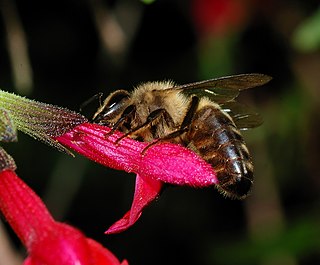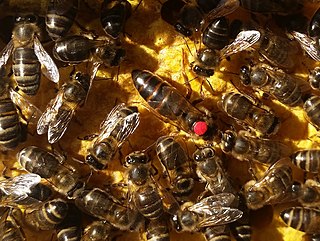
A honey bee is a eusocial flying insect within the genus Apis of the bee clade, all native to Eurasia. They are known for their construction of perennial colonial nests from wax, the large size of their colonies, and surplus production and storage of honey, distinguishing their hives as a prized foraging target of many animals, including honey badgers, bears and human hunter-gatherers. Only eight surviving species of honey bee are recognized, with a total of 43 subspecies, though historically 7 to 11 species are recognized. Honey bees represent only a small fraction of the roughly 20,000 known species of bees.

The Africanized bee, also known as the Africanized honey bee and known colloquially as the "killer bee", is a hybrid of the western honey bee, produced originally by crossbreeding of the East African lowland honey bee (A. m. scutellata) with various European honey bee subspecies such as the Italian honey bee (A. m. ligustica) and the Iberian honey bee (A. m. iberiensis).

The Buckfast bee is a breed of honey bee, a cross of many subspecies and their strains, developed by Brother Adam, who was in charge of beekeeping from 1919 at Buckfast Abbey in Devon in the United Kingdom. Breeding of the Buckfast bee is now done by breeders throughout Europe belonging to the Federation of European Buckfast Beekeepers (G.D.E.B.). This organisation maintains a pedigree for Buckfast bees, originating from the time of Brother Adam.
Within biological taxonomy, a honey bee race would be an informal rank in the taxonomic hierarchy, below the level of subspecies. It has been used as a higher rank than strain, with several strains making up one race. Therefore, a strain is a lower-level taxonomic rank used at the intraspecific level within a race of a subspecies. Strains are often seen as inherently artificial concepts, more usually within biology as characterized by a specific intent for genetic isolation, however, within beekeeping circles, strain is more likely to be used to describe very minor differences throughout the same subspecies, such as the color ranges of A. m. carnica from brown to grey. Within A. m. ligustica there are two races, the darker leather brown northern Italian bee from the Ligurian Alps region which was discovered to be resistant to acarine in the 1900s, while the other Italian bee race, from regions near Bologna and further south, was highly susceptible to acarine and within this race there are two color strains, the traditional Italian yellow and a rarer all-golden color.

The European dark bee is a subspecies of the western honey bee, whose original range stretched from west-central Russia through Northern Europe and probably down to the Iberian Peninsula. They belong to the 'M' lineage of Apis mellifera. They are large for honey bees though they have unusually short tongues (5.7-6.4 mm) and traditionally were called the German Dark Bee or the Black German Bee, names still used today even though they are now considered an Endangered Breed in Germany. Their common name is derived from their brown-black color, with only a few lighter yellow spots on the abdomen. However today they are more likely to be called after the geographic / political region in which they live such as the British Black Bee, the Native Irish Honey Bee, the Cornish Black Bee and the Nordic Brown Bee, even though they are all the same subspecies, with the word “native” often inserted by local beekeepers, even in places where the bee is an introduced foreign species. It was domesticated in Europe and hives were brought to North America in the colonial era in 1622 where they were referred to as the English Fly by the Native American Indians.

The Caucasian honey bee is a subspecies of the western honey bee.

The Cape honey bee or Cape bee is a southern South African subspecies of the western honey bee. They play a major role in South African agriculture and the economy of the Western Cape by pollinating crops and producing honey in the Western Cape region of South Africa.
Lamarck's honey bee or the Egyptian honey bee, Apis mellifera lamarckii, is a subspecies of honey bee native to the Nile valley of Egypt and Sudan, named after Jean-Baptiste Lamarck.

The East African lowland honey bee is a subspecies of the western honey bee. It is native to central, southern and eastern Africa, though at the southern extreme it is replaced by the Cape honey bee. This subspecies has been determined to constitute one part of the ancestry of the Africanized bees spreading through America.

The Macedonian bee is a subspecies of the Western honey bee. It is found mainly in North Macedonia, Northern Greece and other places in the Balkans as well. Originally this subspecies was described based on morphological characteristics by Friedrich Ruttner, as were the adami, cecropia and cypria subspecies.

The western honey bee or European honey bee is the most common of the 7–12 species of honey bees worldwide. The genus name Apis is Latin for "bee", and mellifera is the Latin for "honey-bearing", referring to the species' production of honey.
Apis mellifera iberiensis, or the Spanish bee, is a Western honey bee subspecies native to the Iberian Peninsula. Also found in the Balearic Islands.

Apis cerana, the eastern honey bee, Asiatic honey bee or Asian honey bee, is a species of honey bee native to southern, southeastern, and eastern Asia. This species is the sister species of Apis koschevnikovi and both are in the same subgenus as the western (European) honey bee, Apis mellifera. A. cerana is known to live sympatrically along with Apis koschevnikovi within the same geographic location. Apis cerana colonies are known for building nests consisting of multiple combs in cavities containing a small entrance, presumably for defense against invasion by individuals of another nest. The diet of this honey bee species consists mostly of pollen and nectar, or honey. Moreover, Apis cerana is known for its highly social behavior, reflective of its classification as a type of honey bee.
Beekeeping in Ireland has been practiced for close to 1500 years and has seen a surge in popularity in modern times, evidenced by the numerous organisations promoting and assisting beekeeping. Despite the increased pressures on bees and beekeepers through new diseases and loss of habitat, there are now in excess of 3,500 members within beekeeping associations.

Apis mellifera intermissa is an African subspecies of the western honey bee.
Apis mellifera cypria(Cyprus honey bee) is a subspecies of the Western honey bee. Its primary habitat is the Mediterranean.
Apis mellifera anatoliaca is known commonly as the Anatolian honey bee.
Apis mellifera adami is a western honey bee subspecies from the Mediterranean area, endemic to Crete.
The Arabian honey bee is a subspecies of the western honey bee. It is native to the southern Arabian Peninsula, south of the Sahara, Sudan and Somalia. Based on morphological studies by Friedrich Ruttner, it is classified as a tropical African bee group.











